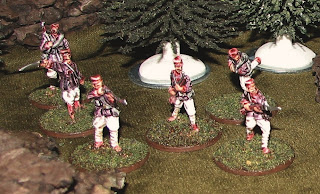The mustering of these two finished armies marks quite a milestone for me. These are the first matched armies I've ever finished, in many, many years in this hobby. While working on these armies, I learned a lot about how to organize my time, how to break down a project into small, discrete steps, and how to keep my energy focused on completion. The temptation toward distraction was strong. Several times I nearly put these aside in order to start working on the metal armies for this imagi-nation campaign.
Without further mumbling, here are the two armies, mustered for your enjoyment and comment.
The armies, together, fit into a single plastic tray, with only minimal stacking of one unit atop another. To the fore we have the French army, with the Allies to their rear. The long compartment on the right holds the tools of paper miniature making: double-sided tape (much handier and friendlier to water-soluable printer inks than glue), a good pair of nail scissors, a straight-edge for folding, and a razor knife. Both of these latter are hidden beneath a bag of spare artillery figures and some unassembled command figures.
Also in there are some as-yet unfinished infantry units. These armies are now (almost...see below) large enough to fight any of the scenarios in Grant's "Scenarios for Wargames," and, therefore, are plenty large enough. The unfinished units may be added later, to allow me build the armies large enough to refight Quatre Bras, should the Napoleonics bug bite in the future.
The plan is to buy a compartmented, hinge-topped, plastic storage tray in which these two armies will be stored, and safely travel with me on business trips. The plastic tray you see here is one of my "project in progress" trays, used to keep a project organized and easily un-shelved for work as time permits.
The Allied army. The British and one brigade of the KGL are in the foreground, the British Guards behind them. Behind the Guards is the Brunswick Corps. On the right flank are the Dutch (front) and Hanoverian (rear) complements. As you can see, there are only two brigades of cavalry (one Dutch, one Brunswicker). So, OK, the army isn't quite large enough to play all of the Grant scenarios yet. I'll need to create, print and assemble three more Allied cavalry units to really be done, but these are all I had, as these units were originally made for the Napoleonic Quatre Bras project.
The British Corps. Line infantry, including one brigade of the KGL and one of Highlanders, supported by their artillery. The Guards are in line behind. The Duke of Wellington, commander of the Allied army, with his aide, can be seen behind the front line. The Brunswick Corps is formed up to the rear of the Guards.
The Brunswickers, in a bit more detail. For some reason, when I created these units, I neglected to give the 2nd (line) Brigade a standard. An oversight, to be sure, as every other unit has one. Some day, I may correct this.
The massed French army. The Grand Battery formed to the front, Ligne and Legere infantry behind, and the Cavalry formed at the rear.
French Ligne (Line) infantry, with two brigades of Legere (Light) infantry behind. The French didn't form brigades exclusively of Legere battalions. I chose to use Legere figures for those brigades dominated by light infantry battalions (the 1st Brigade, 5th Division, and the 1st Brigade, 6th Division, at Quatre Bras). I may choose to represent Grant's Light Infantry units with these brigades.
The massed guns of the French Grand Battery. It's almost impossible to tell, in this picture or in person, but the last battery in the line has a heavy 12# cannon. I need to find a way to quickly distinguish heavy batteries from field batteries from horse batteries. I toyed with using the number of crew figures to distinguish them (5 = heavy, 4 = field, 3 = horse), but three figures and a cannon on the base looked puny, especially as the light 6# cannon are noticeably smaller. I may simply mark the back of each stand with the battery type.
The French Cavalry. Carabiniers, two Brigades of Cuirassiers, Dragoons, Chasseurs and Lanciers. Which is an odd mix for Quatre Bras. Frankly, I don't remember what I was thinking when I made these units up. But, they'll work very nicely for the purposes of these battles.
Coming soon, some shots of these units upon the hexagonal Chessex field of battle given so generously to me by a friend. And then, with luck, a game!



















